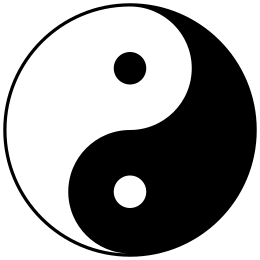Now that I have described symmetry let us consider our response to it.
Symmetry is attractive to us cognitively and (more relevant to this website), emotionally.
Sometimes we are drawn to something, or some process, or indeed a relationship, in an emotional way without fully understanding why at a cognitive level.
For example many people are annoyed by a picture hanging crookedly on a wall. Why is this? And long term relationships, where one partner has a lot of power and another has little, (i.e. that are asymmetric) will inevitably be problematic.
It is probably easier to see why a relationship where one person has very little power is problematic – it is a basic human need to have a felt sense of our own power, we have mentioned this a number of times (and will mention it again) – but why the crooked picture irritates is harder to figure out.
I believe that the reason why symmetry appeals to us is because we tend towards symmetry. For example, we are (approximately) symmetric about a vertical axis (eyes, ears, limbs, etc.), as is evident from Leonardo’s picture above.
For people who live, as we say, to a ripe old age, the passage of life is symmetric. We go from having no existence, to being born, (dependent) growing up, maturing, reaching a peak of health, fitness and performance, then beginning to decay and then finally reaching old age (often dependent again) then dying, and ceasing to exist again. (At my age I know all about this)! If this doesn’t happen, that is, if someone dies young, and unexpectedly, it causes far more distress than the death of the person who lives to the ripe old age.
The day is symmetric about midday (and midnight) and the year is symmetric about mid-summer’s day and mid-winter’s day. If we take time to observe the natural world, we will note that it is symmetrical.
Here’s an interesting one! Stones, large and small, that we find on a beach, are smoothed to either flattish spheres or flattish oval shapes. They are almost all roughly symmetrical. I wager that when they broke off from whatever cliff or rock, aeons ago, they were asymmetric random shapes, but isn’t it amazing that through exposure to wind, rain and sea many of them became symmetrical.
From a grain of sand to the Milky Way Galaxy, we can observe symmetry at all levels of our Universe.
We construct our environment (i.e. buildings, transport, dress, etc.) symmetrically not only because it pleases us aesthetically, but also because it is physically, and practically, the best way to construct (and protect) it.
And our sense of symmetry in respect of our physicality (balance) is also evident in how we find it easier to carry two heavy bags than one heavy bag. And did you ever try and walk with one shoe on and one shoe off? And why do we wear matching socks – surely it wouldn’t matter a jot in respect of our comfort, safety, well-being, work performance etc. if we went out in the morning wearing different socks.
Symmetry is also evident in our songs and stories, myths and legends. A good song or story will contain a contrast that the listener or reader is attracted to.
As a fan of pop music in my youth I remember a song by The Byrds entitled Turn-Turn-Turn which (I later discovered) was a cover of a song written by Pete Seeger in the 1950’s and which (I later again discovered) was a quotation from the Bible (Ecclesiastes 3:1. They are probably the most symmetrical lyrics that you will ever hear!
Sometimes, curiously, if we are down, we feel better if we hear a sad song. I believe that this is a symmetric response by us because we perceive the singer of the song to be empathising with us in our feeling down.
When we talk with, or to, pre-verbal children we often use unintelligible sounds like they use because we instinctively know that connection is enhanced by making those sounds; the same as they make. And then when they learn to talk we use simple words and phrases. Interestingly, it is when we are cross or giving out that we use a different tone of voice (and language) – asymmetry.
Most good stories will contain a goodie and a baddie which seem to act as figures onto which the reader can project parts of his/her own personality. (See the Exercise on Projection below). This, as we stated in the Chapter in Section One on Important Descriptions, i.e. The Media, also makes things exciting.
Fairness and equality are very important elements in the human experience and there is a symmetrical dimension to acting in a fair manner.
In a kind of global example of the asymmetric relationship I referred to already where one person has no power in a partnership, many of the deepest problems that beset society emanate from injustice, or asymmetry, that is, the reality that one person (or group of people) is getting far more and/or is far more powerful than another.
(Colonialism is an example of asymmetry in power relationships – many wars, terrorism etc. have origins in injustice that arises from asymmetric behaviour).




